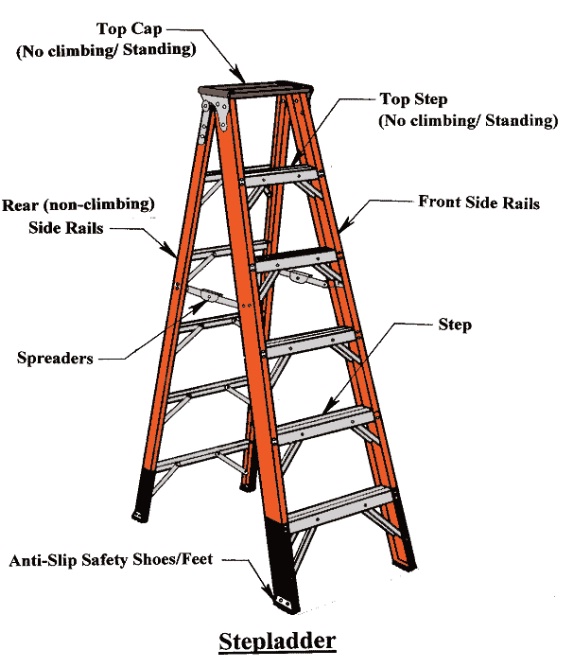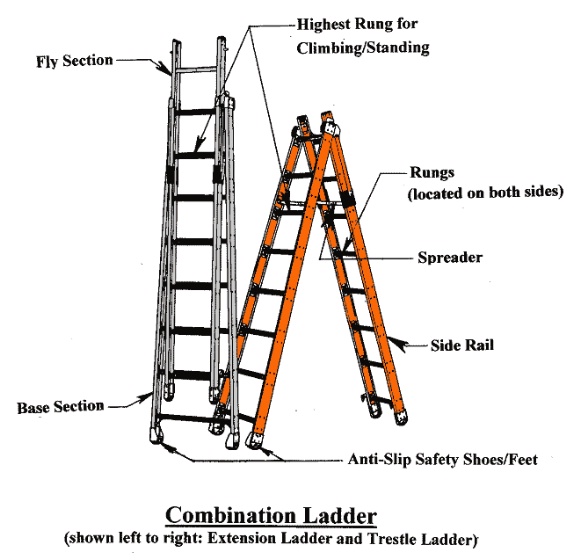Ladders come in various materials, each with unique properties. Understanding these materials helps you choose the right ladder.
Ladders are essential tools used in homes, workplaces, and construction sites. They provide access to high places safely and efficiently. The material of a ladder affects its durability, weight, and suitability for different tasks. Common materials include wood, aluminum, fiberglass, and steel.
Each material offers distinct advantages and potential drawbacks, depending on the use case. For instance, wood ladders are sturdy but can be heavy, while aluminum ladders are lightweight but may not be suitable for electrical work. By learning about the materials used in ladder construction, you can make informed decisions and ensure safety and effectiveness in your tasks.

Credit: www.laddersukdirect.co.uk
Common Ladder Materials
When choosing a ladder, the material is a key factor. Different materials offer unique benefits. Here’s a look at the common ladder materials.
Wood
Wood ladders are classic and reliable. They are often used in painting and electrical work. Wood does not conduct electricity, making it safe for electricians. These ladders are sturdy and can hold a lot of weight. However, they can be heavy and difficult to move. Wood ladders also require regular maintenance to avoid damage from moisture and insects.
Common types of wood used include:
- Pine
- Oak
- Fir
A table comparing wood ladder features:
| Feature | Detail |
|---|---|
| Conductivity | Non-conductive |
| Weight | Heavy |
| Maintenance | High |
Aluminum
Aluminum ladders are lightweight and easy to carry. They are resistant to rust and corrosion. This makes them ideal for outdoor use. Aluminum ladders are also durable and can withstand rough treatment. However, they do conduct electricity, which can be dangerous around power lines. These ladders are often used in construction and home improvement projects.
Key benefits of aluminum ladders include:
- Lightweight
- Rust-resistant
- Durable
An overview of aluminum ladder characteristics:
| Feature | Detail |
|---|---|
| Conductivity | Conductive |
| Weight | Light |
| Maintenance | Low |
Wooden Ladders
Wooden ladders have been around for centuries. They are reliable and sturdy. Many people still prefer them for various uses. They bring a classic touch to any workspace.
Pros And Cons
Pros:
- Wooden ladders are non-conductive. This makes them safe for electrical work.
- They are often heavier, which can provide stability.
- Wooden ladders are durable with proper care.
- They have a natural, aesthetic appeal.
Cons:
- Wood can rot if exposed to moisture.
- They are heavier, making them hard to move.
- Wooden ladders can be more expensive than other types.
- They require more maintenance to stay in good condition.
Maintenance Tips
- Regularly inspect the ladder for cracks or damage.
- Keep the ladder dry to prevent rot and decay.
- Store indoors to protect from weather elements.
- Sand and repaint if the surface becomes rough or splintered.
- Tighten any loose screws or bolts to maintain stability.
Follow these tips to keep your wooden ladder in good shape. Proper care ensures safety and extends the ladder’s lifespan.
Aluminum Ladders
Aluminum ladders are popular in homes and workplaces. They are known for their lightweight and durability. These ladders have become a preferred choice for many due to their various benefits.
Advantages
Aluminum ladders offer several advantages. Firstly, they are lightweight. This makes them easy to carry and move around. Secondly, aluminum is rust-resistant. This ensures the ladder remains in good condition over time, even in damp environments.
Additionally, aluminum ladders are durable. They can withstand heavy use without damage. They also come in various sizes and styles, making them versatile for different tasks.
- Lightweight and easy to carry
- Rust-resistant and durable
- Available in various sizes and styles
Safety Considerations
While aluminum ladders are safe, some precautions are needed. Avoid using them near electrical wires. Aluminum conducts electricity, posing a shock hazard. Always inspect the ladder before use. Check for any signs of damage or wear.
Ensure the ladder is placed on a stable surface. This prevents it from tipping over. Do not exceed the weight limit of the ladder. Overloading can cause it to collapse.
- Avoid using near electrical wires
- Inspect for damage before use
- Place on a stable surface
- Do not exceed weight limit
Following these safety tips can help prevent accidents and injuries.

Credit: www.americanladderinstitute.org
Fiberglass Ladders
Fiberglass ladders are a popular choice for many professionals and DIY enthusiasts. They are known for their durability, safety features, and resistance to various elements. Fiberglass ladders are especially favored in environments where electrical hazards are a concern.
Benefits
Fiberglass ladders offer several advantages that make them a preferred option:
- Non-conductive: Fiberglass does not conduct electricity, making these ladders safe for electrical work.
- Durable: They are resistant to corrosion, weather, and chemicals.
- Strong: Fiberglass ladders can support heavy weights, ensuring stability.
- Long-lasting: They have a longer lifespan compared to wood or aluminum ladders.
Ideal Uses
Fiberglass ladders are versatile and can be used in various scenarios:
- Electrical Work: Perfect for electricians due to their non-conductive nature.
- Outdoor Projects: Ideal for painting, tree trimming, and other outdoor tasks.
- Industrial Use: Suitable for factories and construction sites where durability is crucial.
- Home Maintenance: Handy for tasks like cleaning gutters or changing light bulbs.
Fiberglass ladders provide a safe, reliable option for many different projects. Their benefits and versatility make them a smart choice for both professionals and homeowners.
Steel Ladders
Steel ladders are a popular choice for many due to their strength and durability. They are highly resistant to wear and tear and can handle heavy loads. In this section, we’ll delve into the advantages and common uses of steel ladders.
Durability
Steel ladders are known for their exceptional durability. They can withstand harsh conditions, making them ideal for industrial use. Unlike wooden ladders, steel ladders are not prone to rotting or warping. This ensures a longer lifespan.
Steel ladders are also resistant to fire. This makes them a safe option in environments where fire hazards are a concern. They can support heavy loads without bending or breaking, which adds to their robustness.
Common Applications
Steel ladders are versatile and used in various settings. Here are some common applications:
- Industrial Settings: Factories and warehouses often use steel ladders. They can handle heavy equipment and frequent use.
- Construction Sites: Steel ladders are common on construction sites. They are strong enough to support workers and materials.
- Home Use: Homeowners use steel ladders for tasks like painting or roof repairs. Their durability ensures safety during these tasks.
- Public Buildings: Schools and hospitals use steel ladders for maintenance work. Their fire resistance is an added safety feature.
Steel ladders are a reliable choice for many applications. Their durability and strength make them suitable for both professional and home use.
Choosing The Right Ladder
Choosing the right ladder is crucial for safety and efficiency. Different ladders serve different purposes and are made from various materials. Understanding these materials helps you make an informed decision.
Factors To Consider
- Weight Capacity: Ensure the ladder supports your weight and any tools.
- Height: Choose a ladder tall enough for your tasks.
- Material: Ladders are made from aluminum, fiberglass, or wood.
- Portability: Consider how easy it is to move the ladder.
- Stability: Look for features like non-slip feet and a wide base.
Usage Scenarios
For indoor tasks: Aluminum ladders are lightweight and easy to carry. They are perfect for painting or changing light bulbs.
For electrical work: Fiberglass ladders are non-conductive and safe. They are ideal for working near power lines or electrical systems.
For outdoor tasks: Wooden ladders are sturdy and durable. They are suitable for gardening or maintenance work.
| Material | Best For | Pros | Cons |
|---|---|---|---|
| Aluminum | Indoor tasks | Lightweight, rust-resistant | Conducts electricity |
| Fiberglass | Electrical work | Non-conductive, durable | Heavier than aluminum |
| Wood | Outdoor tasks | Sturdy, non-conductive | Heavy, can rot |

Credit: www.americanladderinstitute.org
Frequently Asked Questions
What Materials Are Ladders Typically Made From?
Ladders are usually made from aluminum, fiberglass, or wood.
Are Aluminum Ladders Better Than Wooden Ladders?
Aluminum ladders are lighter and resistant to rust, while wooden ladders are sturdy but heavier.
Why Choose Fiberglass Ladders For Electrical Work?
Fiberglass ladders do not conduct electricity, making them safer for electrical tasks.
How Long Do Wooden Ladders Last?
With proper care, wooden ladders can last many years. Keep them dry to prevent rot.
Are There Any Disadvantages To Using Aluminum Ladders?
Aluminum ladders can conduct electricity and might bend under heavy load. Use carefully.
Conclusion
Ladders come in various materials, each with unique benefits. Wood, aluminum, and fiberglass are common choices. Wooden ladders offer stability. Aluminum ladders are lightweight and rust-resistant. Fiberglass ladders provide strength and safety. Choosing the right material depends on your needs.
Consider weight, durability, and safety. Understanding ladder materials helps you make informed decisions. Always select a ladder that suits your tasks. Stay safe and choose wisely.
Recent Posts
Maintaining clean gutters is essential for preventing water damage to your home, and choosing the best ladder for cleaning gutters can make the job much easier and safer. With so many options on the...
Best Ladder for Cleaning Caravan Roof: Top Picks for You Every Adventure!
Today we will discuss the best ladder for cleaning caravan roof. Cleaning caravan roofs is one of the crucial tasks.After many days, a caravan roof can get dirty by debris, dirt, and grime. These can...
